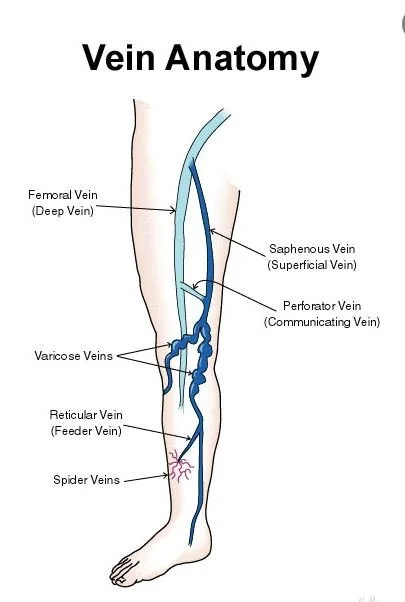A 68 yo. male sp resection for colon cancer in the distal past comes in with leg pain.
What do you notice when you examine his leg?
Our patient had painful varicose veins. Chronic venous disease affects 20- 40% of the US population and is a common cause of lower extremity pain. In our patient the pain became so severe he could no longer walk. He reported he had not been able to sleep more than two hours at a time because of pain.
Chronic nonhealing leg ulcers, bleeding and recurrent phlebitis are problems that can result from venous insufficiency. Our patient had none of these complications.
stasis ulcer present for many years caused by venous insufficiency
Varicose veins are caused by conditions which increase venous pressure and gradually weaken the valves in the veins. Pregnancy, prolonged sitting, congenital vein abnormalities, wearing high heeled shoes, and smoking are risk factors for varicose veins. Although it is possible to have varicosities in the deep venous system, they almost always occur in the superficial veins because they are closer to the skin and lack support from muscles. Muscular contraction compresses the deep veins and causes a pumping action that can cause pressures as high as 5 atmospheres. If a single valve fails a high pressure leak can be created between the deep and superficial systems causing sequential failure of the valves in the superficial system.
Superficial vs deep venous system
Spider veins or telangectasias are another form of venous varicosity. They are small damaged veins that appear on the surface of skin. Telangectasias can be caused by high pressure in the superficial venous systems or reflux but are also associated with scleroderma and multiple congenital conditions like Osler-Weber-Rendu syndrome and Sturge Weber syndrome. Anything that damages superficial veins like radiation, sun exposure or surgical incisions can cause telangectasias.
Both radiofrequency ablation and endovenous laser therapy are treatment options for lower extremity venous disease. In radiofrequency ablation a radiofrequency catheter is passed from the knee to the groin and present heating occurs to shrink the target vessels. This is repeated every 7 cm along the course of the vein. The thermal injury is followed by fibrosis and the results have been excellent out to ten years.
Our patient was seen by a vascular surgeon . After being given the option for surgery, he left the surgeons office and committed suicide. A notebook he left behind indicated severe pain was the reason he killed himself.
Novak C, Khimani N, Kaye A, wt al. current therapeutic interventions in lower extremity venous insufficiency: a comprehensive review. 2019. Current Pain and Headache Reports 23 16.
Chang S, Huang Y, Lee M. er al. Association of varicose veins with incident venous thromboembolism and peripheral artery disease. JAMA 2018 Feb 27.319(8):807-817.
Cho E, Kim J, Kim S.et al. computed tomographic venography for varicose veins of the lower extremities: prospective comparison of 80-kVp and conventional 120-kVp protocols. J Comput Assist Tomogr. 2012 Sept. 36(5): 583-90.



